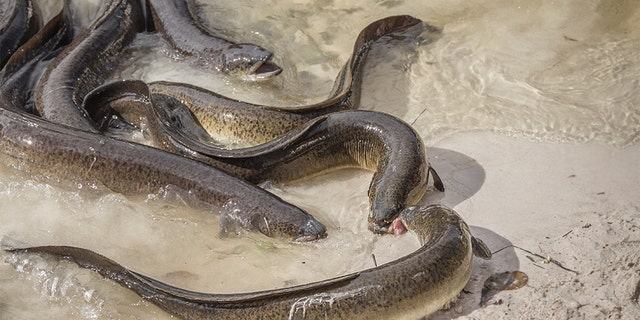World’s oldest eel dies at 155
Cocaine is causing some eels in London's famous River Thames to be "hyperactive," new research by King's College London shows.
A team of scientists at the university studied wastewater that's entering into the river from nearby sewers during storms and found traces of the drug within 24 hours of the overflow, the Independent reports. Compared to other major cities, the level of cocaine entering London's water system — likely through users' urine — is much higher.
"Increases in caffeine, cocaine and benzoylecgonine [a metabolite] were observed 24 hours after sewer overflow events,' King's College London researchers said in a paper that detailed their findings, according to the Evening Standard.
BIZARRE DEEP-SEA FISH LIVING IN GULF OF CALIFORNIA WITH 'VIRTUALLY NO OXYGEN' PUZZLES BIOLOGISTS
London's water treatment plants are tasked with purifying the water but major storms reportedly "overwhelm" the operations and allow some sewage water to make its way into the river.
"Jellyologst" James Robson, a senior curator at SEA LIFE London, told the Independent the addictive drug can have a similar impact on marine animals as it does on humans.

Some eels could be impacted by traces of cocaine getting into the River Thames, scientists say.
(iStock)
“Drugs which affect us will almost always affect all animal life, and invertebrates a little bit more because their biochemistry is much more sensitive,” Robson explained. “Essentially everything in the water will be affected by drugs like these. A lot of the triggers and the ways that cocaine affects the system is really primal.”
The cocaine problem plaguing eels has been discussed before.
HUGE PYTHON IN TOILET GIVES FAMILY A 'FRIGHT,' SHOCKS LOCALS: 'MY WORST NIGHTMARE'
Researchers with the University of Naples Federico II studied the effects the drug had on eels back in June 2018, publishing the results in the Science of the Total Environment.
“Data shows a great presence of illicit drugs and their metabolites in surface waters worldwide,” biologist Anna Capaldo, lead author of the 2018 study, told National Geographic at the time.
The group of biologists put eels in water with drug residue and discovered it made them hyperactive and drastically changed their bodies.
“All the main functions of these animals could be altered,” said Capaldo, explaining the changes in the eels' muscles, hormones and brain after cocaine exposure.
Eels in the Thames aren't as closely exposed to the drug as those in the 2018 study — so it doesn't necessarily mean they're getting "high" from the runoff.
“You haven’t got a lot of disco-dancing fish down the bottom of the Thames," Robson joked to the Independent.
It does, however, spark a debate about wastewater treatment in the city.
“You can basically treat anything to any degree of purity, it’s just about how much money you want to put into the treatment process," Daniel Snow, the director of the Water Sciences Laboratory at the University of Nebraska, told National Geographic.
Source: Read Full Article
